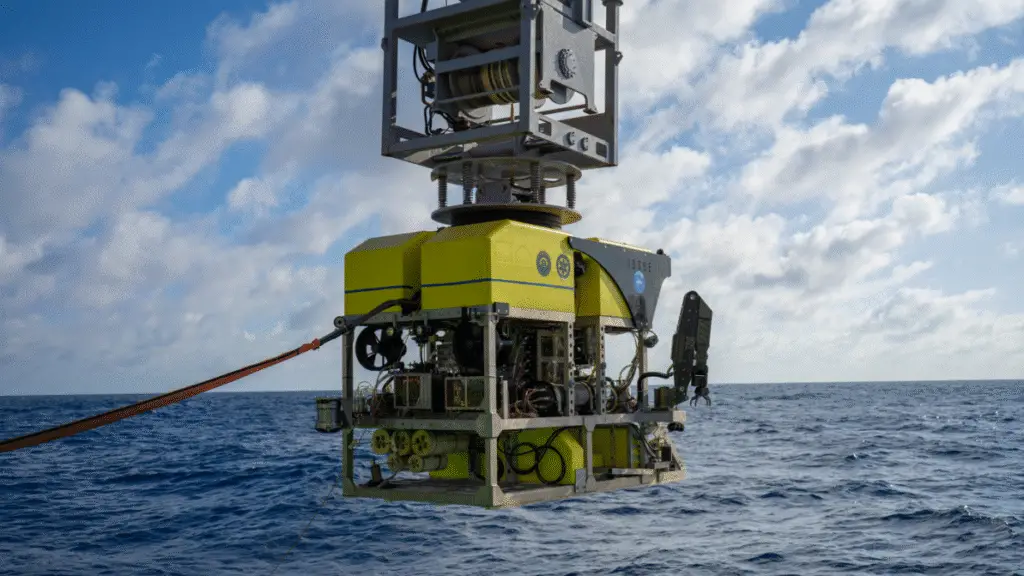On August 23, 2025, China achieved a significant milestone in deep-sea exploration with the successful maiden voyage of its newly developed remotely operated vehicle (ROV), Haiqin.
This advanced China deep-sea robot reached impressive depths in the South China Sea, demonstrating capabilities for future missions at depths of up to 6,000 meters (19,685 feet).
This accomplishment marks another step in China’s ongoing quest to explore the mysteries of the deep ocean. The Haiqin ROV was tested under real operational conditions in the South China Sea.
During its maiden journey, it reached a depth of 4,140 meters (13,582 feet), surpassing expectations for a first mission. Engineers and marine scientists were particularly impressed by the stability of the vehicle in strong underwater currents and the precision of its sensors.
Dr. Liu Wei, a marine technology expert at Shanghai Jiao Tong University, explained, The successful trial confirms that Haiqin can reliably operate in extreme underwater environments. Its performance indicates that we can now conduct deep-sea missions with unprecedented safety and accuracy.
The vehicle’s high definition cameras, sonar systems, and robotic arms enabled researchers to conduct detailed seabed mapping and collect scientific samples. This level of precision is crucial for understanding deep-sea ecosystems, which remain largely unexplored.
Engineering Marvel What Makes Haiqin Special
The China deep-sea robot weighs 3.6 tons and is fully electric, designed for long term scientific research. Its structure is reinforced to withstand immense pressures, and it features advanced automation systems for navigation, hovering, and object manipulation.
One of Haiqin’s most remarkable tools is its robotic arm, capable of collecting delicate biological samples from the ocean floor without damaging them. This capability is vital for marine biologists studying deep-sea life forms, many of which have never been documented.
In addition, the ROV can carry various sensors to measure temperature, pressure, salinity, and chemical composition in the ocean, making it a versatile platform for environmental monitoring and climate research.
During its first mission, Haiqin worked alongside another Chinese unmanned submersible, Haidou-1. This marked the first time two deep-sea robots were deployed simultaneously from a single research vessel.
The collaboration allowed scientists to gather comprehensive data on seabed geology, underwater currents, and marine biodiversity in one coordinated mission. According to Li Ming, a marine engineer involved in the project.
By deploying Haiqin and Haidou-1 together, we can cover more ground, collect more data, and cross verify observations. This is a new era of collaborative deep-sea exploration.
Discoveries from the South China Sea
During the mission, Haiqin successfully mapped previously uncharted sections of the South China Sea seafloor. The ROV identified unique geological formations and collected rock and sediment samples for laboratory analysis.
Marine biologist Dr. Chen Xia noted, The samples we collected using Haiqin are unlike anything we’ve seen before. Some microorganisms in these samples may have applications in medicine, biotechnology, or environmental science.
This mission shows that deep-sea robots are not just tools they are gateways to discovery. Experts worldwide view China’s achievement with interest.
Professor Mark Johnson, a marine technology researcher in the United States, commented, China’s Haiqin ROV demonstrates that the country is rapidly closing the technological gap in deep-sea exploration.
Its ability to reach 6,000 meters is particularly impressive and opens new possibilities for oceanographic research. From an engineering perspective, Haiqin’s stability, maneuverability, and endurance at extreme depths make it one of the most advanced China deep-sea robots in operation today.
Its success sets a benchmark for other nations aiming to expand their underwater research capabilities. The research team aboard the Zhong Shan Da Xue vessel shared unique insights about working with Haiqin.
Captain Zhang Rui described the first deployment, Watching Haiqin descend into the abyss for the first time was both thrilling and nerve wracking. We relied on every sensor and camera feed to ensure the robot performed flawlessly.
Seeing it operate smoothly at 4,000 meters was a moment of pride for everyone on board. Engineers also highlighted the emotional connection they feel with the ROV.
For them, Haiqin is not just a machinenit represents years of dedication, innovation, and the dream of exploring places no human has ever touched.
Future Implications
The successful trial of Haiqin has several important implications for marine science and technology. Haiqin can explore deep-sea ecosystems that remain largely unknown. Studying these regions can improve understanding of biodiversity, ecology, and evolutionary biology.
Deep-sea robots like Haiqin can help monitor ocean conditions that affect climate patterns, such as temperature shifts and chemical composition changes.
While deep-sea mining remains controversial, the ROV can assist in mapping seabed minerals, gas hydrates, and other underwater resources for potential sustainable use.
Developing ROVs that function at extreme depths encourages innovation in robotics, AI, sensors, and materials science, benefiting multiple industries beyond oceanography.
The launch and successful test of the Haiqin ROV marks a remarkable achievement in China’s deep-sea exploration efforts. With its advanced technology, robust design, and collaborative mission capabilities, Haiqin has proven to be a powerful tool for unlocking the mysteries of the deep ocean.
This milestone not only reinforces China’s growing leadership in marine research but also contributes to global scientific understanding.
As Haiqin continues to explore the uncharted depths, we can expect groundbreaking discoveries in marine biology, geology, climate science, and underwater technology.
China’s investment in deep-sea exploration exemplifies the importance of combining engineering excellence, scientific curiosity, and human dedication to push the boundaries of what is possible.
Haiqin’s journey into the deep ocean reminds us that the ocean still holds countless secrets and with the right tools, we are finally beginning to uncover them.

